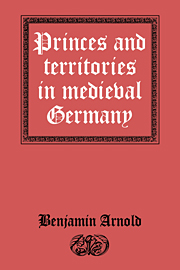Book contents
- Frontmatter
- Contents
- Acknowledgements
- List of abbreviations
- Introduction
- PART I CROWN AND PRINCE
- PART II PRINCELY TITLE AND OFFICE
- 4 The imperial house; German bishops and abbots
- 5 Dukes and duchies
- 6 Counts and the transformation of counties
- 7 Margraves, counts-palatine, burgraves, and landgraves
- PART III DYNASTIES, PRELATES, AND TERRITORIAL DOMINION
- Conclusion
- Index
6 - Counts and the transformation of counties
Published online by Cambridge University Press: 03 December 2009
- Frontmatter
- Contents
- Acknowledgements
- List of abbreviations
- Introduction
- PART I CROWN AND PRINCE
- PART II PRINCELY TITLE AND OFFICE
- 4 The imperial house; German bishops and abbots
- 5 Dukes and duchies
- 6 Counts and the transformation of counties
- 7 Margraves, counts-palatine, burgraves, and landgraves
- PART III DYNASTIES, PRELATES, AND TERRITORIAL DOMINION
- Conclusion
- Index
Summary
After 1100 we have seen the dukedoms reduced from wide military commands and senior representation of the German gentes into the personal exercise of power by prominent ecclesiastical and secular princes over their own possessions. Amongst the princes there was only a handful of dukes even after Frederick Barbarossa's generosity with the title. The typical designation for the aristocrats who were the lords in the regions was count. This title was also changing its meaning by 1100, releasing it from its previous association with public justice exercised under the crown, to apply instead to the cluster of hereditary rights which the dynasty in question exercised, although a comital title was by no means a precondition for this kind of authority. In the twelfth and thirteenth centuries there were many families which enjoyed no title beyond the description nobilis vir or nobleman, and dominus or lord, and yet held jurisdiction over their possessions in the same mode as the dynasties of counts.
Although the changing meaning of ducal titles after 1098 is relatively clear to follow, the technicalities and uses made of comes for count and comitatus for the exercise of his powers had a much more complicated history. It is convenient to divide it into three phases, recognizing that modern scholarship is far from exhibiting consensus about the issues raised. These phases are, firstly, the foundation of comital powers in the Frankish era when they were most closely associated with the king and his fiscal, military, and judicial policy and duties.
- Type
- Chapter
- Information
- Princes and Territories in Medieval Germany , pp. 112 - 120Publisher: Cambridge University PressPrint publication year: 1991

